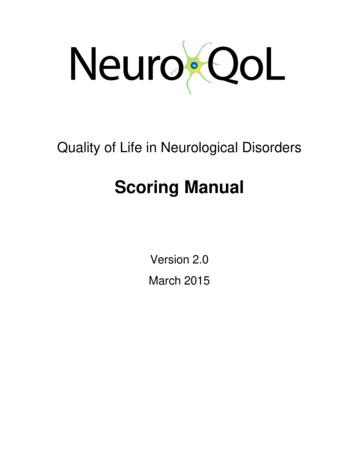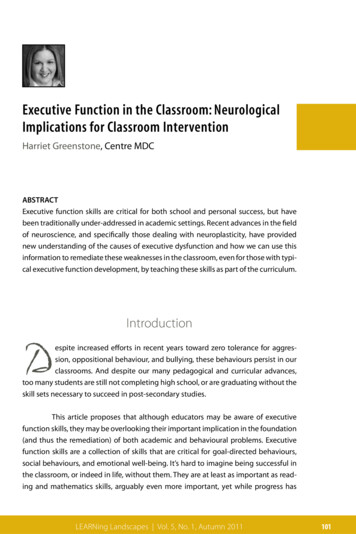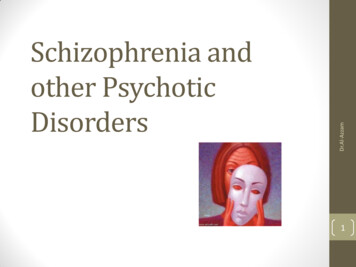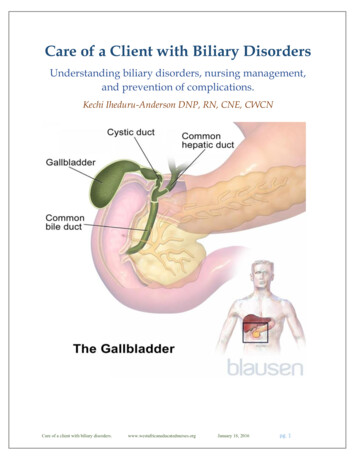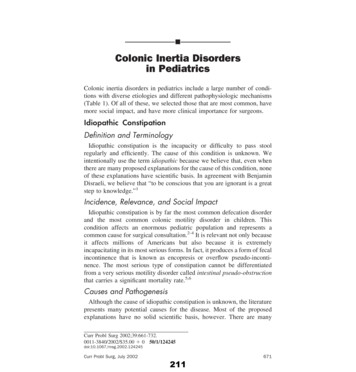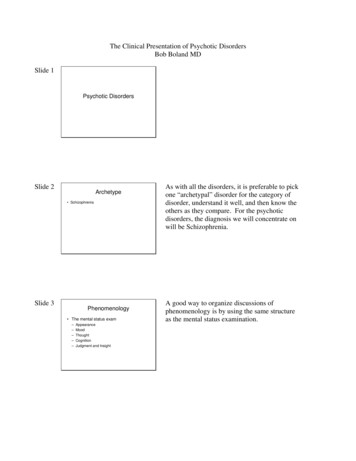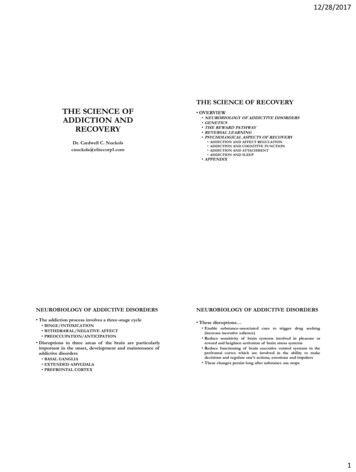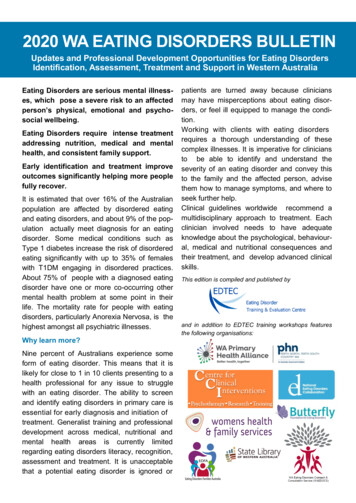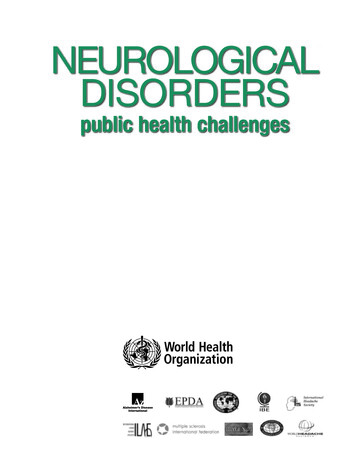
Transcription
NEUROLOGICALDISORDERSpublic health challenges
WHO Library Cataloguing-in-Publication DataNeurological disorders : public health challenges.1.Nervous system diseases. 2.Public health. 3.Cost of illness. I.World Health Organization.ISBN 92 4 156336 2(NLM classification: WL 140)ISBN 978 92 4 156336 9 World Health Organization 2006All rights reserved. Publications of the World Health Organization can be obtained from WHO Press,World Health Organization, 20 Avenue Appia, 1211 Geneva 27, Switzerland (tel.: 41 22 791 3264; fax: 41 22 791 4857; e-mail: bookorders@who.int). Requests for permission to reproduce or translateWHO publications – whether for sale or for noncommercial distribution – should be addressed to WHOPress, at the above address (fax: 41 22 791 4806; e-mail: permissions@who.int).The designations employed and the presentation of the material in this publication do not imply theexpression of any opinion whatsoever on the part of the World Health Organization concerning the legalstatus of any country, territory, city or area or of its authorities, or concerning the delimitation of itsfrontiers or boundaries. Dotted lines on maps represent approximate border lines for which there maynot yet be full agreement.The mention of specific companies or of certain manufacturers’ products does not imply that theyare endorsed or recommended by the World Health Organization in preference to others of a similarnature that are not mentioned. Errors and omissions excepted, the names of proprietary products aredistinguished by initial capital letters.All reasonable precautions have been taken by the World Health Organization to verify the informationcontained in this publication. However, the published material is being distributed without warranty ofany kind, either expressed or implied. The responsibility for the interpretation and use of the materiallies with the reader. In no event shall the World Health Organization be liable for damages arising fromits use.Printed in Switzerland
tionsIntroductionvviiixxi1Chapter 1Public health principles and neurological disorders7Chapter 2Global burden of neurological disorders:estimates and projections27Chapter 3Neurological disorders: a public health lepsyHeadache disordersMultiple sclerosisNeuroinfectionsNeurological disorders associated with malnutritionPain associated with neurological disordersParkinson’s diseaseStrokeTraumatic brain injuries414256708595111127140151164Chapter 4Conclusions and recommendations177AnnexesAnnex 1List of WHO Member States by region and mortality stratum183Annex 2Country income groups used for reporting estimates and projections185Annex 3Global Burden of Disease cause categories, sequelae and casedefinitions for neurological disorders186
ivNeurological disorders: public health challengesAnnex 4Table A.4.1 Burden of neurological disorders, in DALYs, by cause,WHO region and mortality stratum, projections for 2005, 2015 and 2030Table A.4.2 Burden of neurological disorders, in DALYs, by causeand country income category, projections for 2005, 2015 and 2030Table A.4.3 Deaths attributable to neurological disorders, by cause,WHO region and mortality stratum, projections for 2005, 2015 and 2030Table A.4.4 Deaths attributable to neurological disorders, by cause andcountry income category, projections for 2005, 2015 and 2030Table A.4.5 Burden of neurological disorders, in YLDs, by cause,WHO region and mortality stratum, projections for 2005, 2015 and 2030Table A.4.6 Burden of neurological disorders, in YLDs, by cause andcountry income category, projections for 2005, 2015 and 2030Table A.4.7 Prevalence (per 1 000) of neurological disorders, by cause,WHO region and mortality stratum, projections for 2005, 2015 and 2030Table A.4.8 Prevalence (per 1 000) of neurological disorders, by causeand country income category, projections for 2005, 2015 and 2030Annex 5International nongovernmental organizations workingin neurological disorders189193194198199203204208209
vforewordIn the 19th century and at the beginning of the 20th,brain research belonged to many different areas that differed in methodology and targets: the morphological, thephysiological and the psychological. The latter used toconsider the brain as a black box where only the inputand output were known but not at all the neuronal components and the way they interact with each other.At the beginning of the third millennium, due to prolonged ageing, neurodevelopmental disorders are growing and a much deeperknowledge of the brain is necessary. Scientific and technological research,from molecular to behavioural levels, have been carried out in many differentplaces but they have not been developed in a really interdisciplinary way.Research should be based on the convergence of different interconnectedscientific sectors, not in isolation, as was the case in the past.As this report demonstrates, the burden of neurological disorders is reaching a significant proportion in countries with a growing percentage of thepopulation over 65 years old.With this report go my best wishes that it be disseminated worldwide andthat it receive the deserved attention of the Global Health Community in allthe countries of the world.Rita Levi-Montalcini1986 Nobel Prize in Medicine
viiprefaceWithin its remit to provide leadership on all matters concerning health, one of the corefunctions of the World Health Organization (WHO) is to engage in partnerships where jointaction is needed. WHO plays an important role in bringing crucial health-related topics tothe agenda of policy-makers and health planners and in raising awareness of them amonghealth-care professionals and all who have an interest in health matters.WHO’s Department of Mental Health and Substance Abuse carries out this role forthe three different sets of issues for which it is responsible: mental disorders, substanceabuse and alcohol-related issues, and neurological disorders. Two recent publicationshave focused attention on its work. The world health report 2001 – Mental health: newunderstanding, new hope is an advocacy instrument to shed light on the public health aspects of mental disorders, and the report Neuroscience of psychoactive substance use anddependence produced by the department in 2004 tackles the area of substance abuse andalcohol. We realized a similar exercise is needed in the field of neurological disorders.The Global Burden of Disease study, the ongoing international collaborative projectbetween WHO, the World Bank and the Harvard School of Public Health, has produced evidence that pinpoints neurological disorders as one of the greatest threats to public health.A clear message emerges that unless immediate action is taken globally, the neurologicalburden is expected to become an even more serious and unmanageable problem in allcountries. There are several gaps in understanding the many issues related to neurologicaldisorders, but we already know enough about their nature and treatment to be able toshape effective policy responses to some of the most prevalent among them.To fill the vast gap in the knowledge concerning the public health aspects of neurological disorders, this document Neurological disorders: public health challenges fulfils tworoles. On one hand, it provides comprehensive information to the policy-makers and on theother hand, it can also be used as an awareness-raising tool. The document has uniqueaspects that should be stressed. It is the result of a huge effort bringing together the mostsignificant international nongovernmental organizations working in the areas of variousneurological disorders, both in a professional capacity and in caring for people affectedby the conditions. It is the fruit of healthy interaction and collaboration between theseorganizations and WHO, with its network of country and regional offices: health experts on
viiiNeurological disorders: public health challengesone hand working together with the extensive and competent world of professionals andresearchers on the other. Some of these organizations have also contributed financiallyto this endeavour. This exercise thus demonstrates that such collaboration is not onlypossible but can also be very productive.The document is distinctive in its presentation as it provides the public health perspective for neurological disorders in general and presents fresh and updated estimatesand predictions of the global burden borne by them. Separate sections discuss some ofthe most important disorders in detail: dementia, epilepsy, headache disorders, multiplesclerosis, neuroinfections, neurological disorders associated with malnutrition, pain associated with neurological disorders, Parkinson’s disease, stroke and traumatic braininjuries.The document makes a significant contribution to the furthering of knowledge aboutneurological disorders. We hope it will facilitate increased cooperation and innovationand inspire commitment to preventing these debilitating disorders and providing the bestpossible care for people who suffer from them.Benedetto SaracenoDirector, Department of Mental Healthand Substance Abuse
ix1acknowledgementsThe following people, listed in alphabetical order, participated in the production of this document,under the guidance and with the support of Catherine Le Galès-Camus (Assistant Director-General,Noncommunicable Diseases and Mental Health, World Health Organization), to whom we expressour sincere gratitude.PROJECT TEAMWRITING GROUPJohan A. Aarli, Tarun Dua, Aleksandar Janca, Anna MuscettaMANAGEMENT GROUPJosé Manoel Bertolote, Tarun Dua, Aleksandar Janca, Frances Kaskoutas-Norgan,Anna Muscetta, Benedetto Saraceno, Shekhar Saxena, Rosa SeminarioEDITORIAL COMMITTEEJohan A. Aarli, Giuliano Avanzini, José Manoel Bertolote, Hanneke de Boer, Harald Breivik,Tarun Dua, Nori Graham, Aleksandar Janca, Jürg Kesselring, Colin Mathers, Anna Muscetta,Leonid Prilipko, Benedetto Saraceno, Shekhar Saxena, Timothy J. SteinerAUTHORS AND CONTRIBUTORSINTRODUCTIONTarun Dua, Aleksandar Janca, Anna MuscettaCHAPTER 1. PUBLIC HEALTH PRINCIPLESAND NEUROLOGICAL DISORDERSTarun Dua, Aleksandar Janca, Rajendra Kale, Federico Montero, Anna Muscetta, Margie PedenCHAPTER 2. GLOBAL BURDEN OF NEUROLOGICAL DISORDERS:ESTIMATES AND PROJECTIONSTarun Dua, Marco Garrido Cumbrera, Colin Mathers, Shekhar SaxenaCHAPTER 3. NEUROLOGICAL DISORDERS:A PUBLIC HEALTH APPROACH3.1 DementiaAmit Dias, Cleusa Ferri, Nori Graham (chair), Bernard Ineichen, Martin Prince,Richard Uwakwe3.2 EpilepsyGiuliano Avanzini (co-chair), Ettore Beghi, Hanneke de Boer (co-chair), Jerome Engel Jr.,Josemir W. Sander, Peter Wolf3.3 Headache disordersLorenzo Gardella, Zaza Katsarava, David Kernick, Hilkka Kettinen, Shireen Qureshi,Krishnamurthy Ravishankar, Valerie South, Timothy J. Steiner (chair), Lars Jacob Stovner3.4 Multiple sclerosisIan Douglas, Jürg Kesselring (chair), Paul Rompani, Bhim S. Singhal, Alan Thompson3.5 NeuroinfectionsReyna M. Duron, Hector Hugo Garcia, Ashraf Kurdi, Marco T. Medina (chair),Luis C. Rodriguez
xNeurological disorders: public health challenges3.6 Neurological disorders associated with malnutritionAmadou Gallo Diop (chair), Athanase Millogo, Isidore Obot, Ismael Thiam, Thorkild Tylleskar3.7 Pain associated with neurological disordersMichael Bond, Harald Breivik (chair), Troels S. Jensen, Willem Scholten, Olaitan Soyannwo,Rolf-Detlef Treede3.8 Parkinson’s diseaseMary Baker (chair), Oscar S. Gershanik3.9 StrokeJulien Bogousslavsky (chair), Ming Liu, J. Moncayo, B. Norrving, A. Tsiskaridze,T. Yamaguchi, F. Yatsu3.10 Traumatic brain injuriesArmando Basso (chair), Ignacio Previgliano, Franco ServadeiCHAPTER 4. CONCLUSIONS AND RECOMMENDATIONSJosé Manoel Bertolote, Tarun Dua, Aleksandar Janca, Anna Muscetta,Benedetto Saraceno, Shekhar SaxenaEXTERNAL REVIEWERSMario A. Battaglia, Donna Bergen, Gretchen Birbeck, Carol Brayne, Vijay Chandra, Amit Dias,M. Gourie-Devi, Rajendra Kale, Maria Lucia Lebrao, Itzhak Levav, Girish Modi, Theodore Munsat,Donald Silberberg (whole document); Daniel O’Connor, Carlos Lima (Dementia); SatishJain, Bryan Kies (Epilepsy); Anne MacGregor, Fumihiko Sakai (Headache disorders); ChrisH. Polman, Ernie Willoughby (Multiple sclerosis); Peter G. E. Kennedy (Neuroinfections);Redda Tekle Haimanot (Neurological disorders associated with malnutrition); Ralf Baron,Maija Haanpää (Pain associated with neurological disorders); Zvezdan Pirtosek, Bhim S. Singhal,Helio Teive (Parkinson’s disease); Vladimir Hachinski, David Russell (Stroke); Vladan Bajtajic,Jacques Brotchi, Jeremy Ganz, Haldor Slettebø (Traumatic brain injuries)PEER REVIEWERS IN WHORegional Office for Africa: Thérèse AgossouRegional Office for the Americas: José Miguel Caldas De Almeida, Itzhak LevavRegional Office for South-East Asia: Vijay ChandraRegional Office for Europe: Matthijs MuijenRegional Office for the Eastern Mediterranean: R. Srinivasa Murthy, Mohammad Taghi YasamyRegional Office for the Western Pacific: Xiandong WangHeadquarters: Bruno de Benoist, Siobhan Crowley, Denis Daumerie, Dirk Engels,Jean Georges Jannin, Daniel Olivier Lavanchy, Dermot Maher, Kamini Mendis, Shanthi Mendis,François Meslin, William Perea, Pascal Ringwald, Oliver Rosenbauer, Michael J. Ryan,Perez Simarro, Jos Vandelaer, Marco VitoriaPRODUCTION TEAMProduction coordination: Caroline AllsoppEditing: Barbara CampaniniDesign and layout: Reda SadkiProofreading: Susan KaplanIndexing: David McAllisterMaps: Steve EwartPrinting coordination: Raphaël Crettaz
NFPAVaDWFNWFNSWHAWHOYLDYLLAlzheimer’s diseaseAlzheimer’s Disease Internationalantiepileptic drugacquired immunodeficiency syndromeantiretroviral therapybehavioural and psychological symptoms of dementiacentral nervous systemcomplex regional pain syndromece
between WHO, the World Bank and the Harvard School of Public Health, has produced evi-dence that pinpoints neurological disorders as one of the greatest threats to public health. A clear message emerges that unless immediate action is taken globally, the neurological burden is expected to become an even more serious and unmanageable problem in all countries. There are several gaps in .
